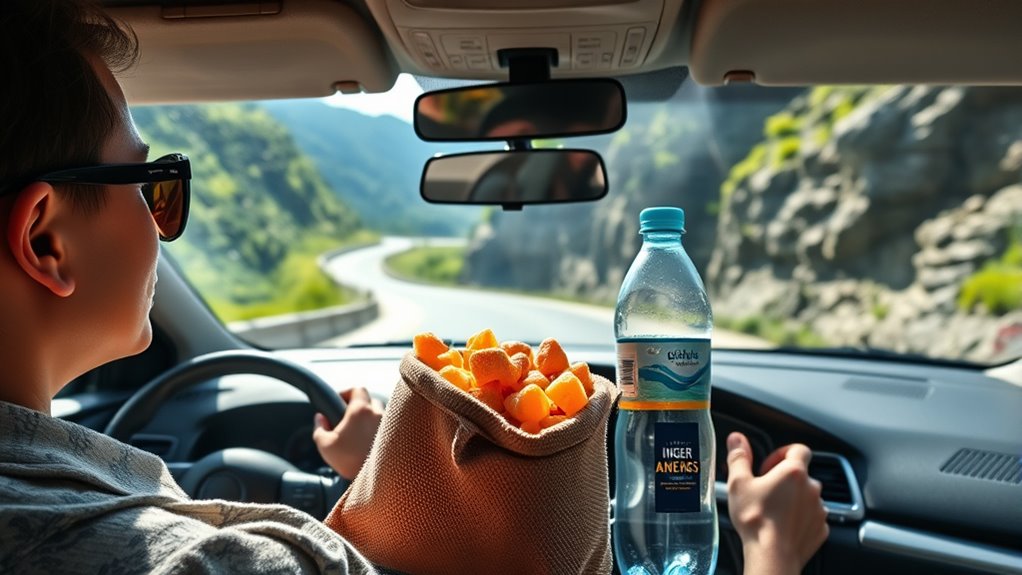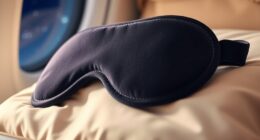To manage car sickness on winding roads, choose a seat near the front or over the wheels for less motion, and sit upright for better balance. Focus on the horizon or a fixed point outside your window, and stay well-hydrated with light snacks. Fresh air and calming music can also help. Using natural remedies like ginger or acupressure wristbands, along with medications if needed, can improve comfort. Keep these tips in mind to make your ride smoother and more enjoyable.
Key Takeaways
- Sit in the front seat or over the wheels to reduce motion sensation on winding roads.
- Focus on the distant horizon or a fixed point outside to stabilize your visual field.
- Keep windows open or use air conditioning for fresh air circulation and to prevent odors.
- Take ginger candies, tea, or supplements beforehand to soothe your stomach during turns.
- Practice deep breathing and relaxation techniques to lessen anxiety and physical discomfort.
Choosing the Right Seat for Comfort

Have you ever wondered why some seats in a car cause less motion sickness than others? It all comes down to where you sit. Sitting in the front passenger seat often provides a more stable experience because you’re closer to the car’s center of gravity, reducing the feeling of swaying. If possible, opt for a seat near the front or in the middle, where motion is less intense. Sit upright to improve your balance and reduce dizziness. Avoid seats near the rear or on the edges, where motion feels more exaggerated. Make sure your seat offers good support, so you stay comfortable and alert. Choosing the right seat can make a noticeable difference in how sensitive you are to motion, helping you feel better during winding journeys. Additionally, understanding how AI detection methods analyze motion-related content can provide insights into how technology monitors and addresses visual discomfort during travel. Practicing mindfulness techniques such as deep breathing while traveling can also help manage feelings of nausea and promote relaxation. Being aware of optimal seating positions can further enhance your comfort and reduce symptoms of car sickness.
Practical Tips for Reducing Motion Sickness

To minimize motion sickness during car rides, try keeping your focus on the horizon or a fixed point outside the vehicle. This helps your brain reconcile visual cues with the movement you feel, reducing nausea. Additionally, stay well-hydrated, avoid heavy meals before traveling, and take short breaks if possible. Fresh air can also help; crack a window or use the air conditioner. Incorporating these strategies can also support remote work habits by reducing stress and improving overall comfort during travel. You can also consider using motion sickness remedies or techniques to further alleviate symptoms. Here’s a quick reference:
| Tip | Why it helps | How to do it |
|---|---|---|
| Focus on the horizon | Stabilizes visual input | Look out the front window |
| Keep hydrated | Prevents dehydration | Drink water regularly |
| Fresh air | Eases nausea | Open a window or vent |
Implementing these simple strategies can make your ride more comfortable.
How to Use Natural Remedies and Medications

Natural remedies and medications can effectively alleviate car sickness when used appropriately. Ginger is a popular natural remedy; you can try ginger tea, candies, or supplements to help settle your stomach. Acupressure wristbands apply pressure to specific points and may reduce nausea for some people. Over-the-counter medications like dimenhydrinate or meclizine are commonly used to prevent motion sickness; take them 30 to 60 minutes before your trip for best results. Always follow dosing instructions and consider any health conditions or allergies. If you’re unsure, consult your healthcare provider to choose the right medication. Combining natural remedies with medications can provide additional relief. Additionally, selecting a properly designed toilet can make bathroom visits more comfortable and hygienic, especially for those prone to nausea or discomfort. Using motion sickness prevention techniques such as proper seating position and distraction methods can also improve your experience on winding roads. Incorporating air purifiers in the vehicle may also help reduce airborne irritants that could worsen nausea for sensitive individuals. Engaging in relaxation techniques, such as deep breathing exercises, can further help manage symptoms during travel.
Tips for Preparing Before Your Journey

Preparing your body and environment before starting your journey can considerably reduce the chances of car sickness. Begin by getting plenty of rest the night before, as tiredness can worsen symptoms. Eat a light, bland meal about an hour before you leave—avoid greasy or spicy foods that may upset your stomach. Stay hydrated, but don’t overdo it; sipping water or ginger tea can help settle nausea. Choose a comfortable seat, ideally near the front or over the wheels, to minimize motion. Ventilate the car well or open a window slightly for fresh air. Remove strong odors or clutter that could trigger nausea. Ultimately, avoid reading or looking at screens during the drive to keep your focus steady and prevent unnecessary discomfort. Additionally, motion sensitivity can be reduced by focusing on the horizon or a fixed point in the distance. Adjusting the contrast ratio of your environment by dimming interior lights can also help lessen visual strain and discomfort during travel. To further enhance comfort, consider using wireless headphones to listen to calming music or audiobooks without disturbing other passengers. Keeping your sense of control by opening windows or adjusting climate controls can also help alleviate symptoms.
Strategies to Stay Calm During the Ride

Staying calm during the ride can considerably reduce your chances of experiencing car sickness. When you’re anxious or tense, your body reacts more strongly to motion, increasing nausea. To stay calm, focus on relaxing your muscles and breathing deeply. Keep your attention on something steady outside the car, like the horizon. Listening to calming music or practicing gentle mindfulness can also help. Avoid looking at screens or reading, which can worsen symptoms. Sitting in the front seat often helps you feel more in control and less anxious. If you start feeling uneasy, try to take slow, deep breaths. Incorporating mindfulness practices during your ride can further help maintain a relaxed state. Additionally, ensuring your vehicle has good ventilation can prevent stuffiness and reduce discomfort. Proper hydration is also important, as drinking water can help alleviate some symptoms of motion sickness. Recognizing narcissistic behavior patterns in oneself, such as overreacting to minor discomfort, can aid in managing symptoms better. Remember, staying relaxed keeps your body at ease, making it easier to handle winding roads without discomfort.
Frequently Asked Questions
Can Children Outgrow Car Sickness?
Yes, children can outgrow car sickness as they develop. You might notice that your child’s symptoms lessen over time, especially with exposure and practice. Keep in mind, some children may still experience it into adolescence. To help, encourage them to look out the window, sit in the front, or take breaks. Patience and gentle strategies often lead to improvement, making car rides more comfortable for everyone.
Are There Specific Foods That Worsen Motion Sickness?
Oh, sure, load up on greasy fries and sugary snacks before your road trip—because who doesn’t want their stomach doing somersaults? In reality, spicy, greasy, or heavy foods can worsen motion sickness, making you feel worse on winding roads. Instead, stick to light, bland snacks like crackers or toast. Staying hydrated and avoiding alcohol also helps keep nausea at bay. Your stomach will thank you, even if your eyes don’t.
How Does Car Design Influence Sickness?
Car design plays a big role in how you experience motion sickness. If your vehicle has large windows, you can look outside to stabilize your vision and reduce nausea. Smooth suspension minimizes jolts and vibrations, making rides more comfortable. Seats aligned to minimize head movement help you stay balanced. Good airflow and climate control also prevent discomfort. When you choose a car with thoughtful design, you’re less likely to feel sick on winding roads.
Is It Safe to Use Over-The-Counter Motion Sickness Medication?
Like a captain steering through stormy seas, you wonder if over-the-counter motion sickness meds are safe. Generally, they’re effective and safe when used as directed, but they can cause drowsiness or interact with other medications. Always read the label carefully and consult your doctor if you’re unsure or have health conditions. Your safety is the lighthouse guiding you through potential fog, so take precautions before your journey.
Can Acupressure Bands Effectively Prevent Car Sickness?
Acupressure bands can be effective in preventing car sickness for some people. They work by applying pressure to specific points on your wrist, which may help reduce nausea. While not everyone experiences the same relief, many find them worth trying as a natural alternative to medication. Keep in mind, for best results, wear the bands snugly but comfortably and give them a chance to work before your trip.
Conclusion
So there you have it—your foolproof plan to conquer car sickness on winding roads. Because nothing says “adventure” like fighting nausea while pretending you’re enjoying the scenery. Follow these tips, stay calm, and maybe even enjoy the ride (or at least not ruin everyone’s trip). Remember, a little preparation and a dash of humor can turn a nauseating journey into just another story to brag about—preferably one without the stomach churning. Happy travels!









